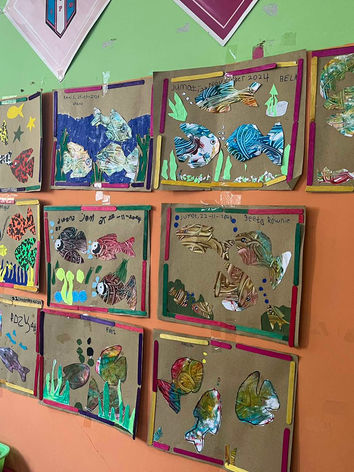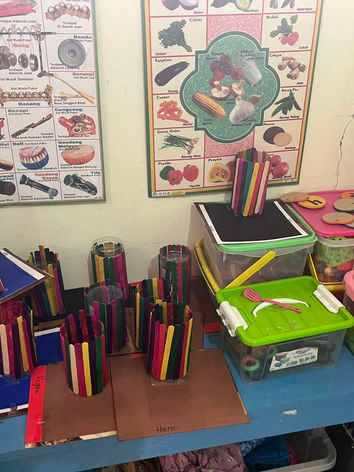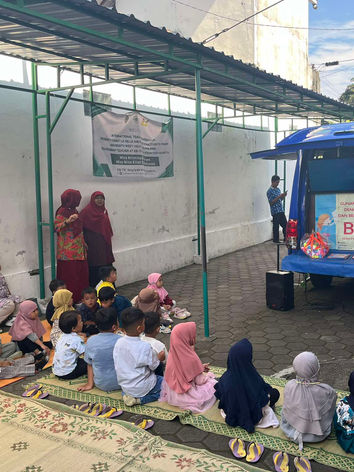
PEDAGOGICAL CONTENTS
2.1 Teaching Methods
At TK ABA Nitikan, teaching methods blend structured routines with student-centered approaches that foster engagement and active participation. The school follows the Merdeka Curriculum, which emphasizes flexibility and student-centered learning. Key teaching strategies observed include:
Circle Time & Discussion
Each morning begins with a prayer, followed by sharing sessions where students talk about their experiences from the previous day or holidays. Teachers also provide advice, reminders, and discussions on topics such as the weather, weekends, and previous lessons.
Experiential & Hands-On Learning
Children participate in rotational activities, with teachers preparing three different activities from Tuesday to Friday. These include painting, threading, clay modeling, sand play, cutting, and other sensory-based activities aligned with the weekly theme.
Inquiry-Based Learning
Teachers encourage students to ask and answer questions during discussions and after watching educational videos. Following these videos, students engage in concept mapping, where they take charge of organizing and detailing key concepts from the lesson.
Play-Based Learning
Both indoor and outdoor free play are integral to the curriculum, emphasizing the importance of play in child development.
Storytelling & Singing
Songs, chants, and storytelling are frequently used to reinforce learning, particularly for memorization and comprehension of concepts, and moral values.
Reward System
A star-based reward system motivates students by recognizing their participation, discipline, and performance. Students earn stars for actively engaging in class and fulfilling their promises. At the end of each week, they count their accumulated stars, and the teacher ranks them based on their total.
2.2 Learning Materials and Innovations
TK ABA Nitikan integrates diverse and engaging learning materials to enrich children's learning experiences. Some of the key resources include:
Traditional and Digital Resources
Flashcards and charts are commonly used for literacy and numeracy activities. Teachers also incorporate digital media, such as educational videos and lectures, to enhance learning and engagement.
Manipulatives and Hands-On Tools
Each classroom is equipped with a cabinet full of sensory materials, including blocks, sand trays, threading kits, clay, sticks, and more. Every student has a personal learning kit or art kit, which contains essential materials for art class, such as a drawing book, coloring sets, glue, scissors, and other creative supplies.
Innovative Teaching Aids
The school uses cut-out syllables for spelling activities and word formation games. Additionally, Jarimatika, a finger-based arithmetic method, is offered as an extra class to provide an alternative approach to learning math.
Mobile Library
A mobile library visits the school, providing children with access to a wide range of books to enhance their literacy skills and foster a love for reading.
2.3 Sources of Learning and Technology
At TK ABA Nitikan, the primary source of learning comes from teachers' explanations, demonstrations, and direct guidance. Educators play a crucial role in facilitating lessons by providing structured instruction and hands-on support to ensure students grasp concepts effectively.
Teachers use various teaching tools such as flashcards, charts, cut-outs, and concept mapping to help students develop essential skills and gain a thorough understanding of the topic assigned for the week. Additionally, educational videos and digital media are incorporated into lessons to make learning more engaging and interactive. The school also employs project-based activities, allowing students to engage in meaningful, hands-on experiences that develop critical thinking and problem-solving skills. Through this approach, children actively participate in exploring concepts, conducting simple investigations, and applying their learning to real-world situations. As part of its numeracy program, the school offers an extra class on Jarimatika, a finger-based arithmetic method that helps young learners grasp mathematical concepts more easily.
TK 'Aisyiyah Bustanul Athfal Nitikan follows the Merdeka Curriculum, which ensures a well-rounded education through intracurricular, co-curricular, and extracurricular activities. The curriculum is designed to support academic, social, emotional, and spiritual development by integrating Islamic teachings, technology, and cultural education. Islamic values are reinforced through Qur’anic lessons, daily prayers, and religious practices, instilling a strong foundation of faith and character in students. Beyond the classroom, facilities such as the playground play a vital role in learning. The playground serves as a space for active exploration, social interaction, and physical development, allowing children to engage in unstructured play that enhances their motor skills, creativity, and teamwork. Additionally, cultural learning is actively promoted through extracurricular classes that expose children to traditional Indonesian music and martial arts. Students participate in activities such as playing the angklung, joining the drum band, and learning Tapak Suci. The school also encourages children to explore their environment through nature-based learning, play-based exploration, and hands-on activities.
2.4 Authentic Assessment
The school employs various assessment methods to evaluate children’s learning and development. These include observation-based assessment, where teachers closely monitor children's participation, behavior, and engagement in daily activities; project-based assessment, in which students demonstrate their learning through rotational activities aligned with the weekly theme; and self-directed learning and choice-based assessment, which allows students to select activities based on their interests, fostering independence and decision-making skills. Additionally, the religious and ethical assessment evaluates students' participation in prayers and Qur’anic recitations, ensuring the development of spiritual discipline and moral values. Lastly, peer interaction and social behavior assessment is conducted through daily routines, where teachers observe students’ ability to collaborate, share, and build positive relationships with their classmates.
























